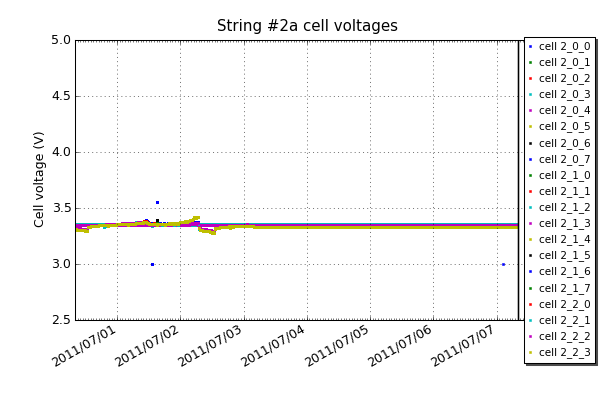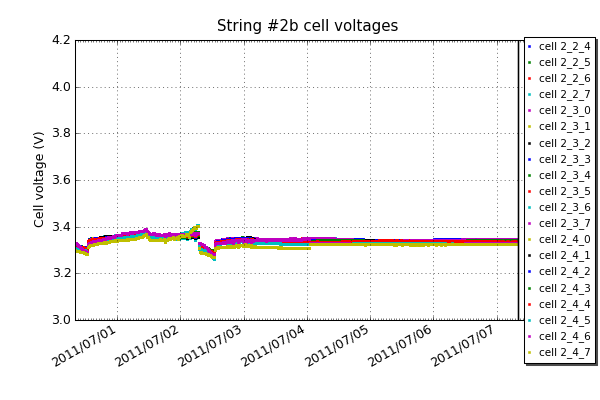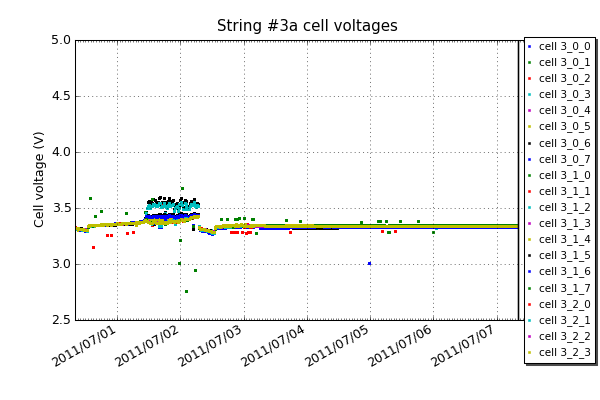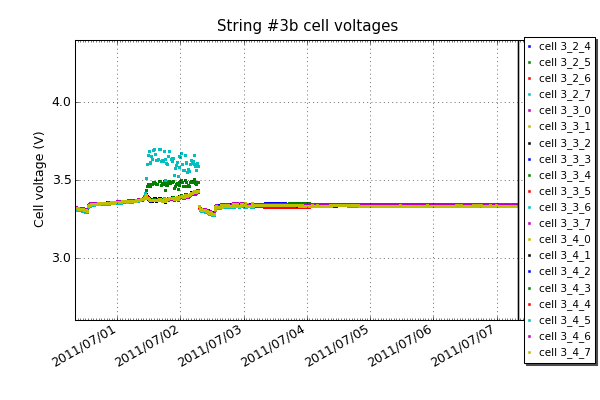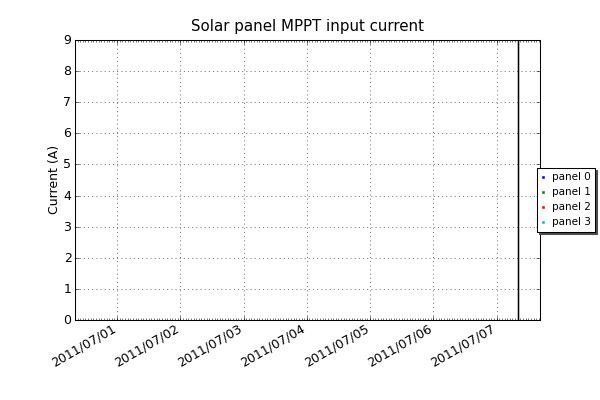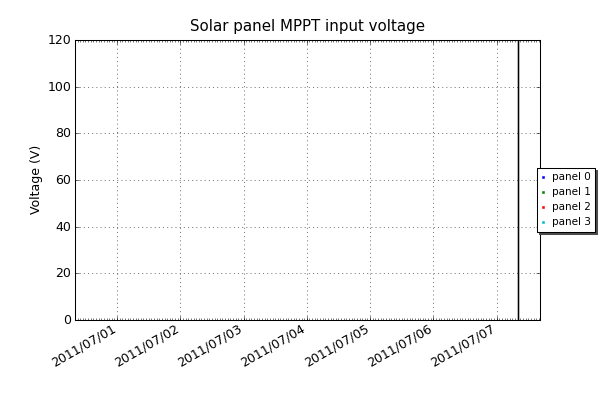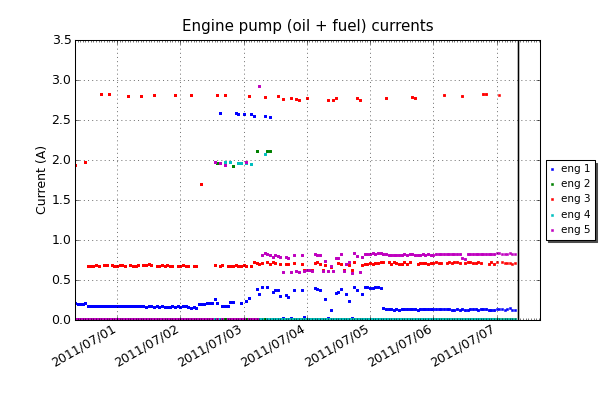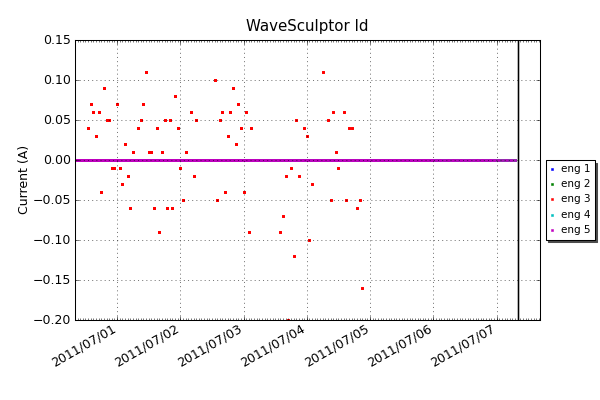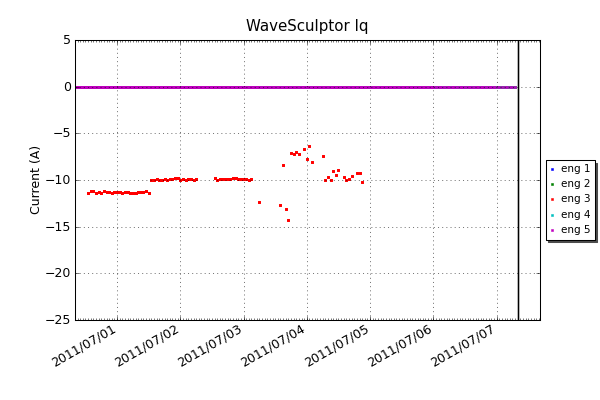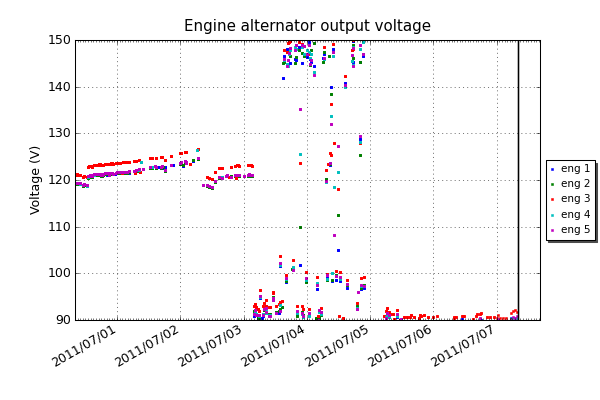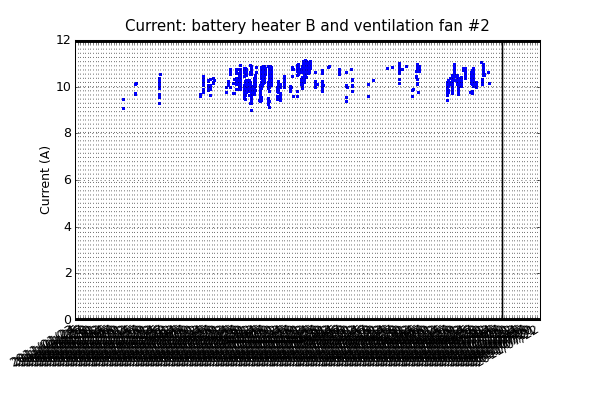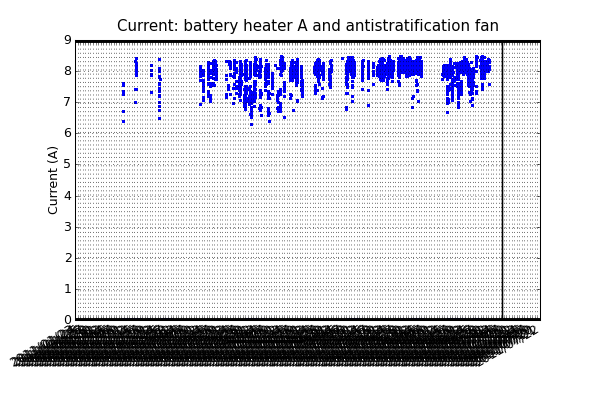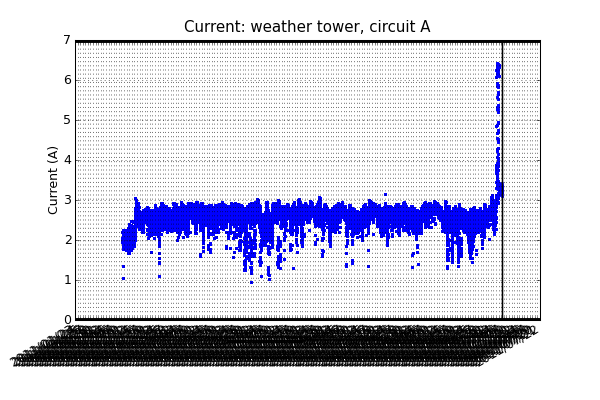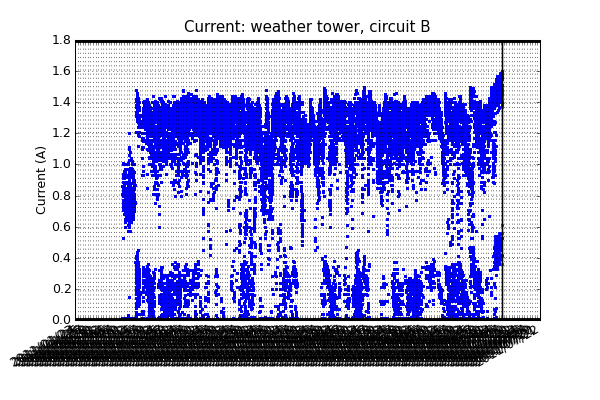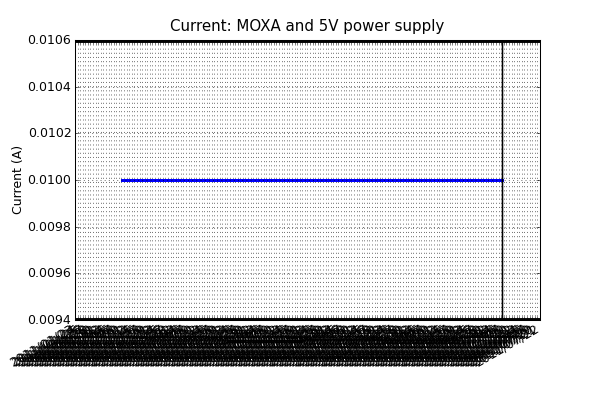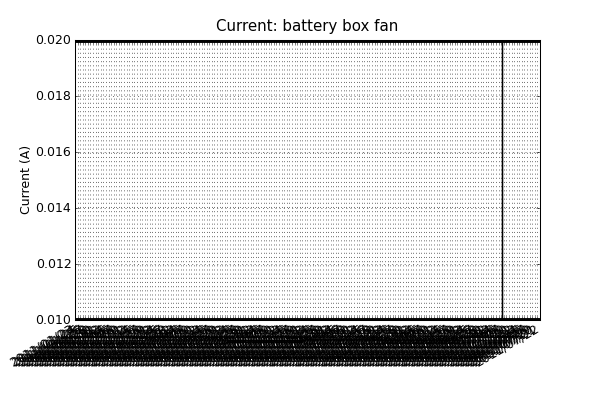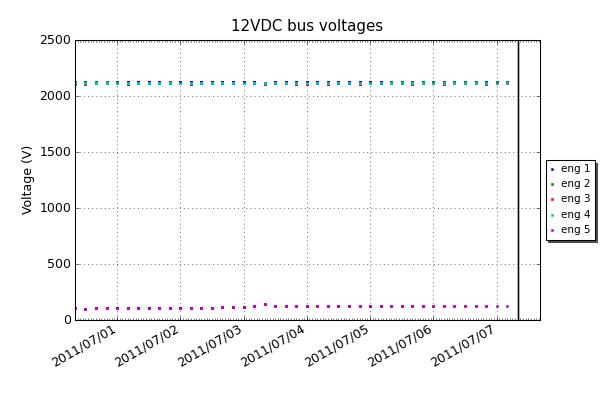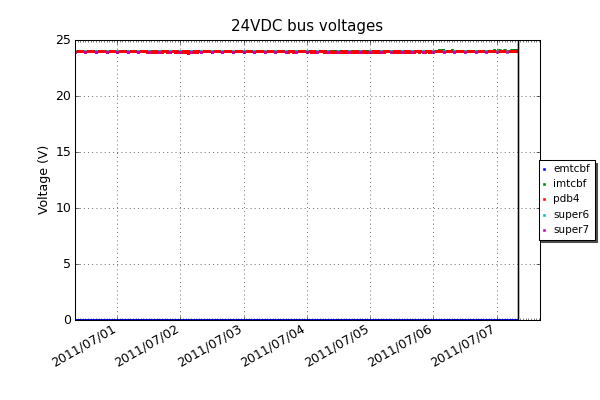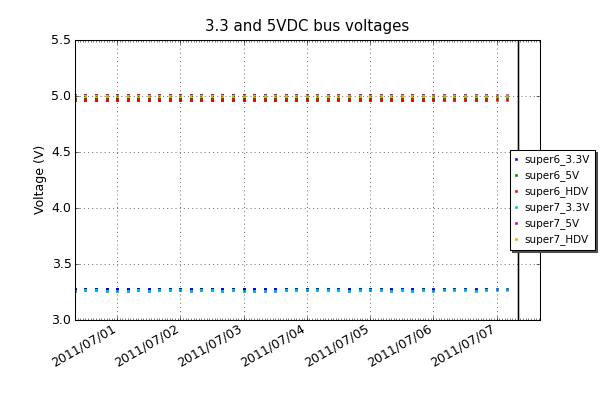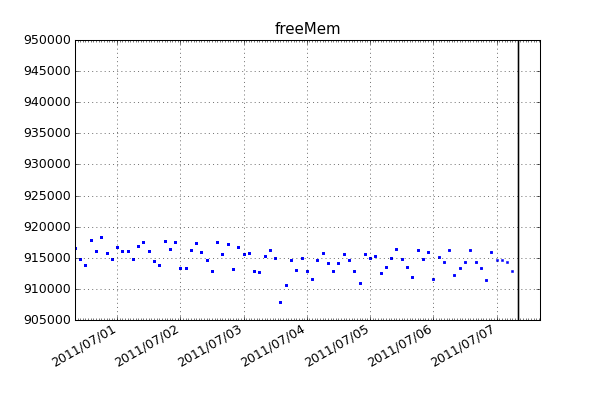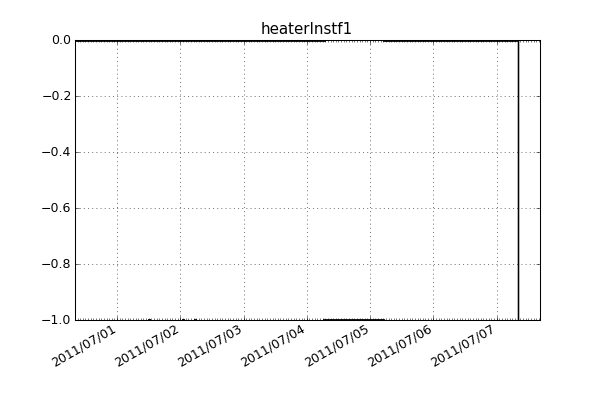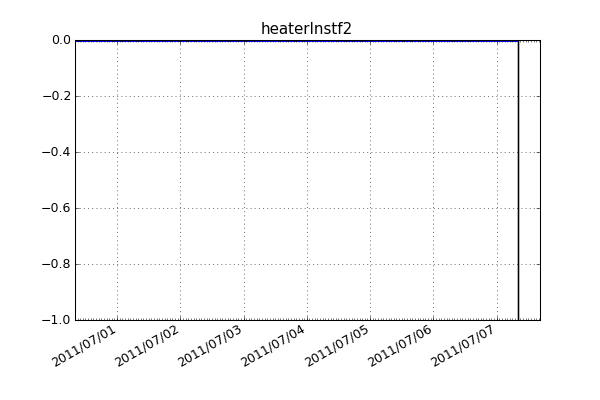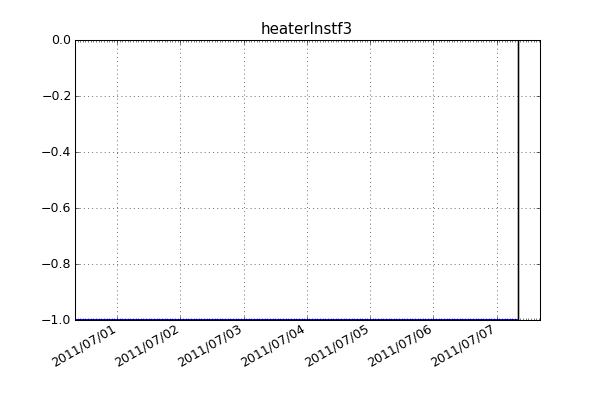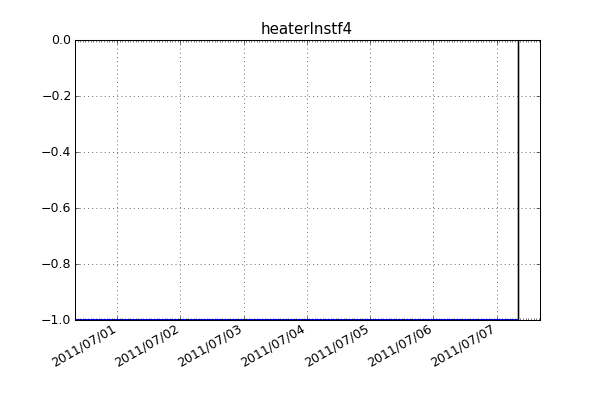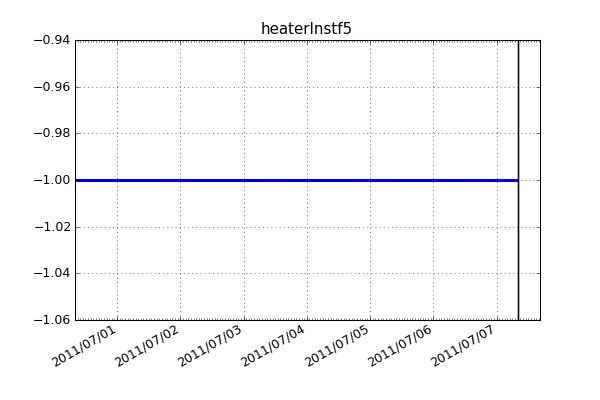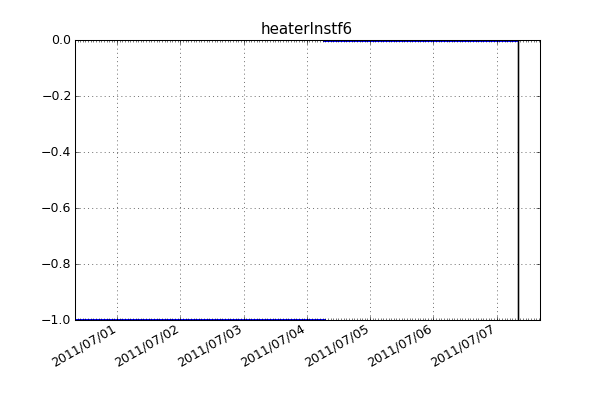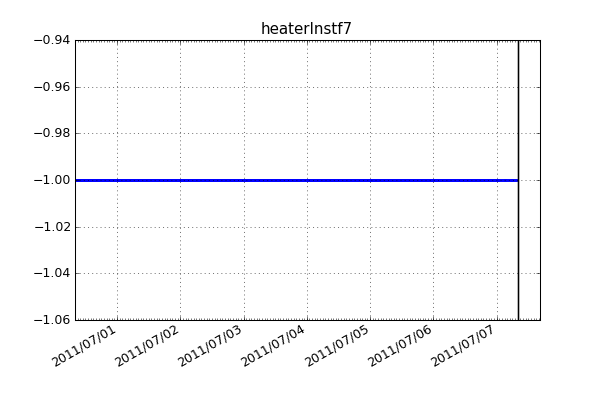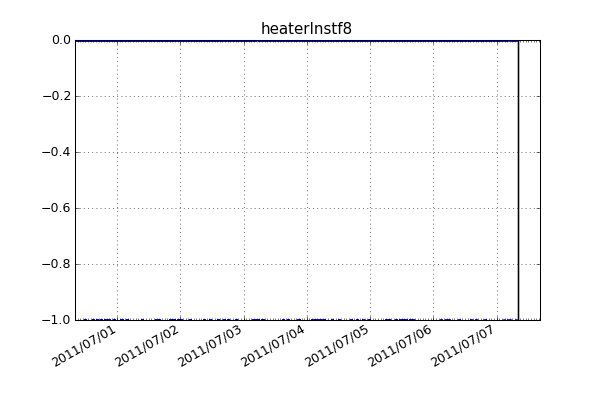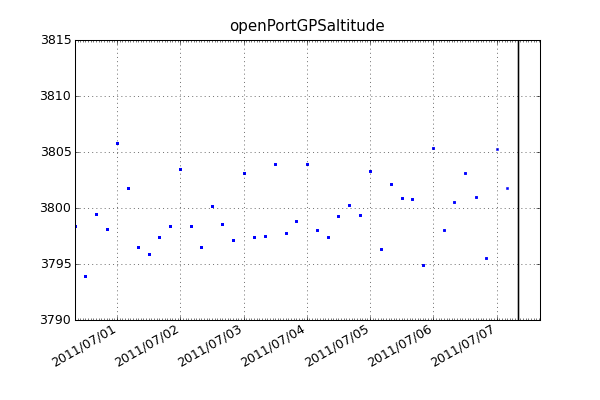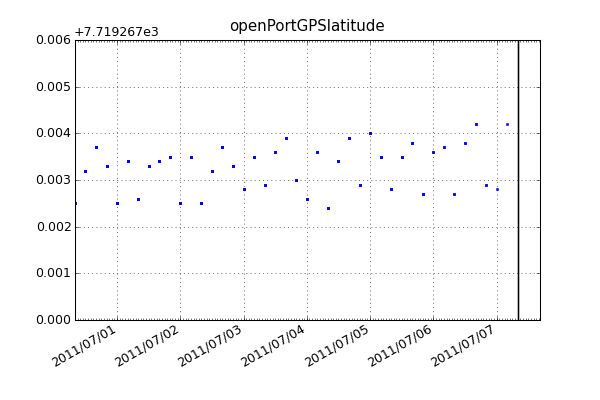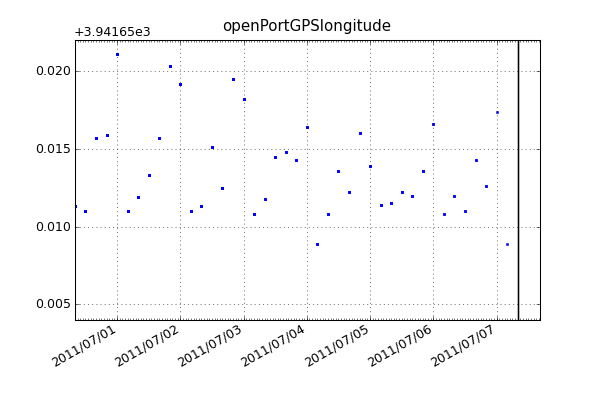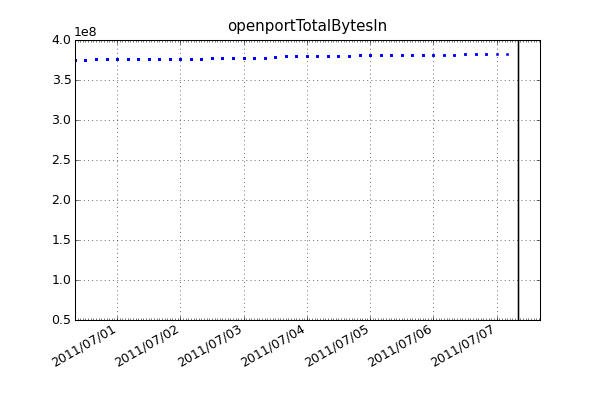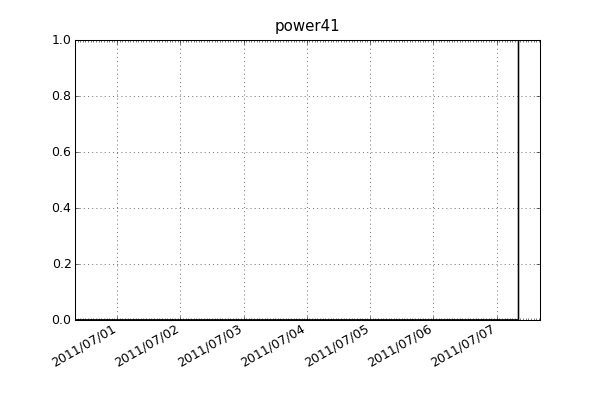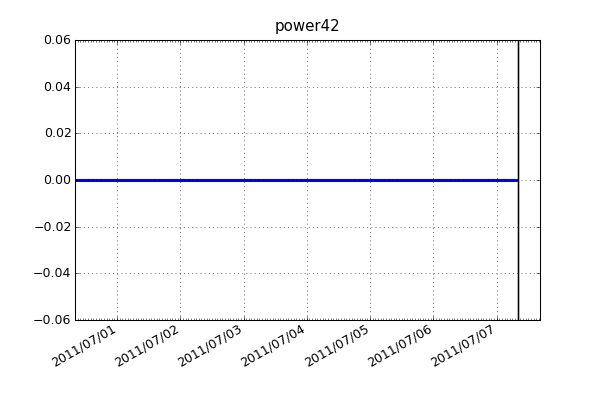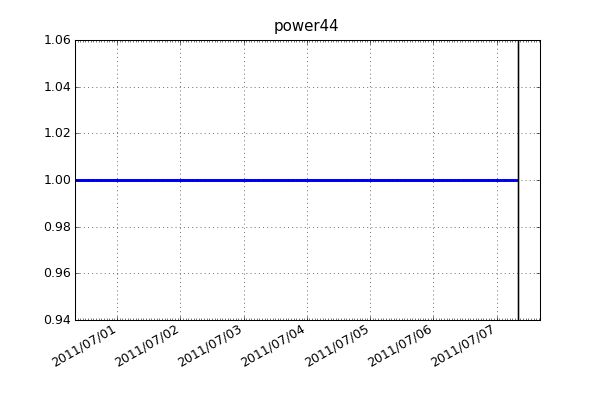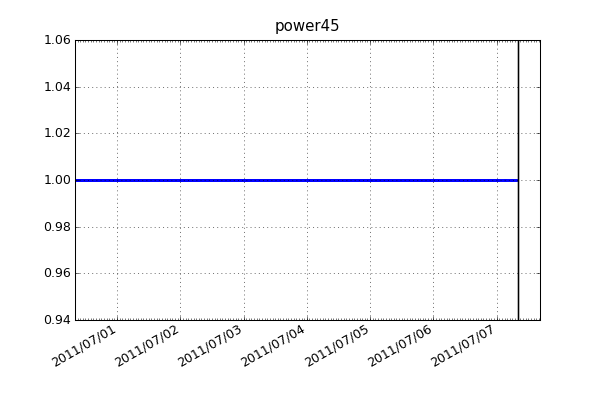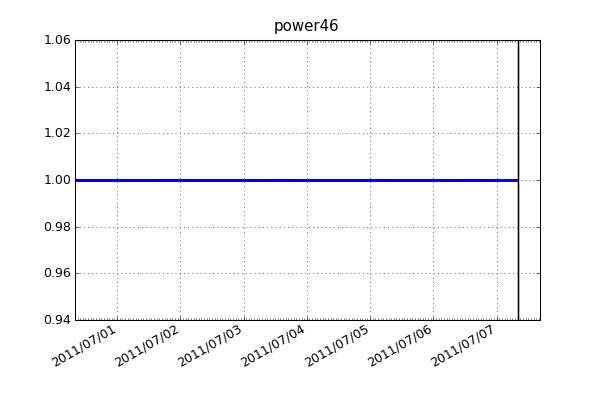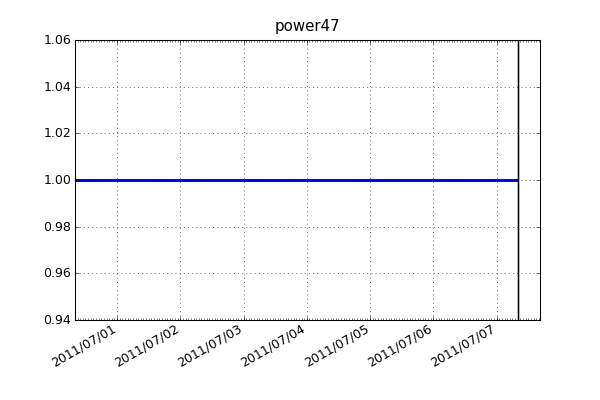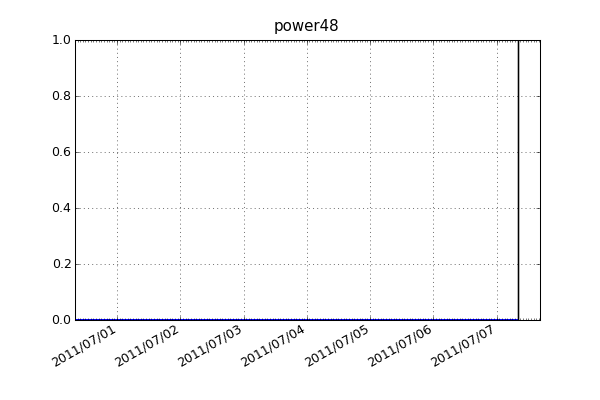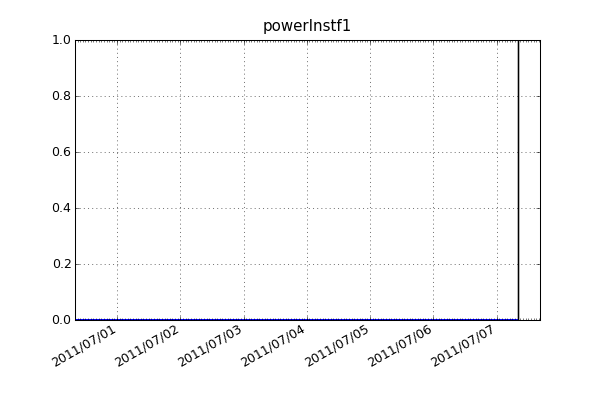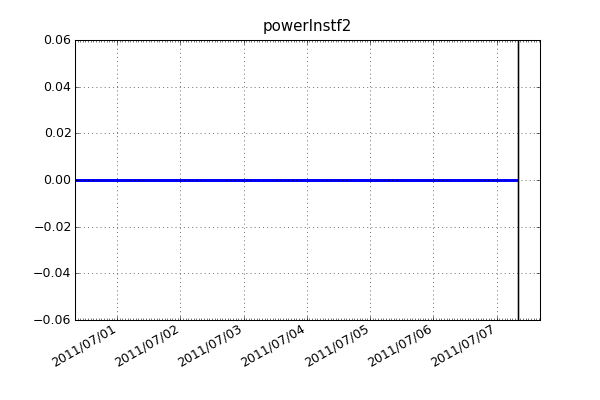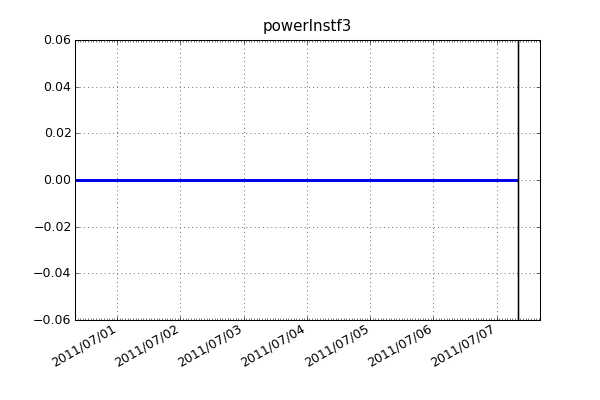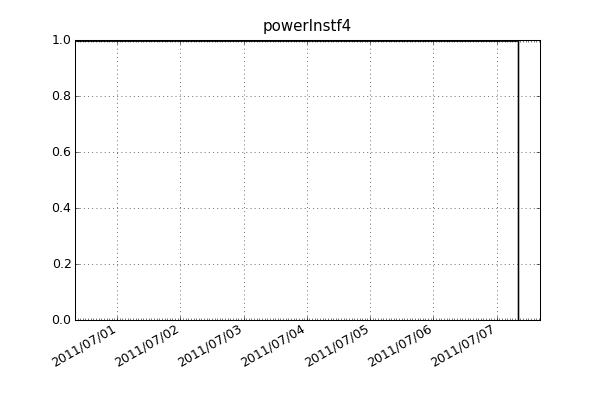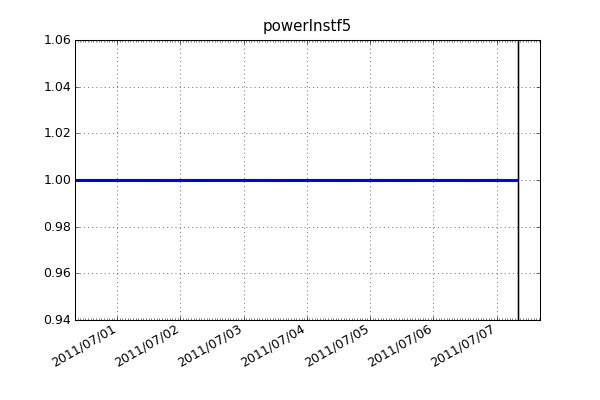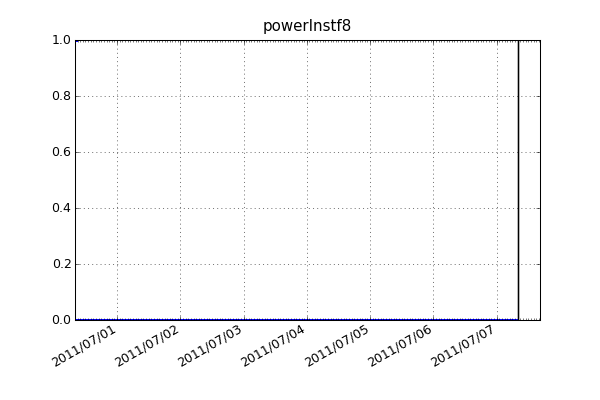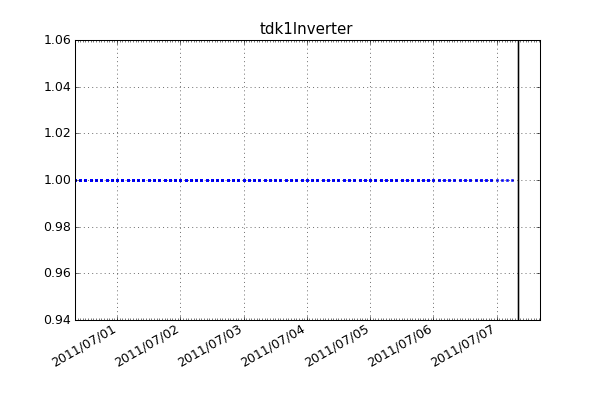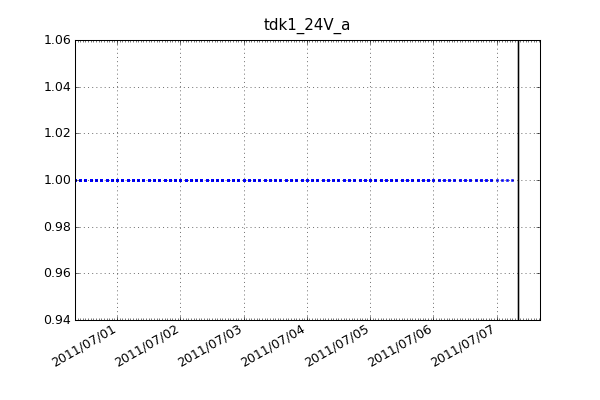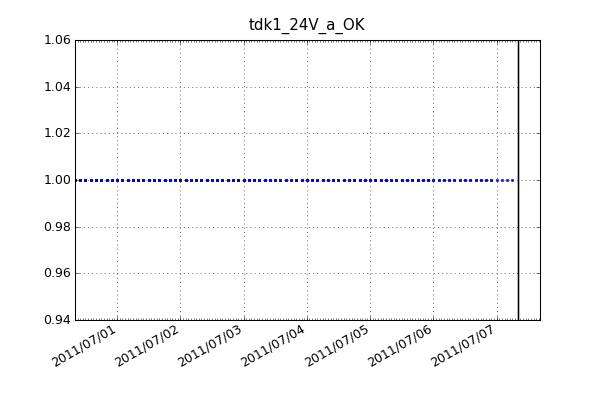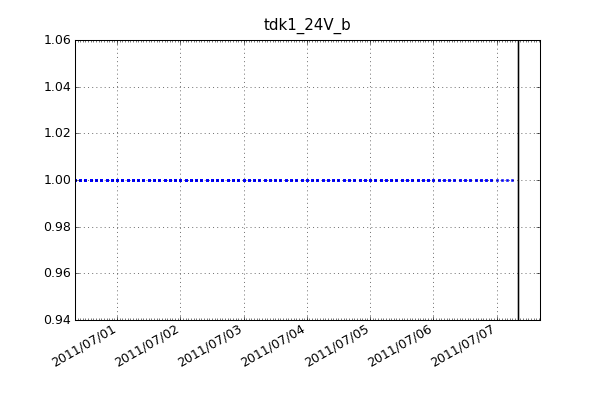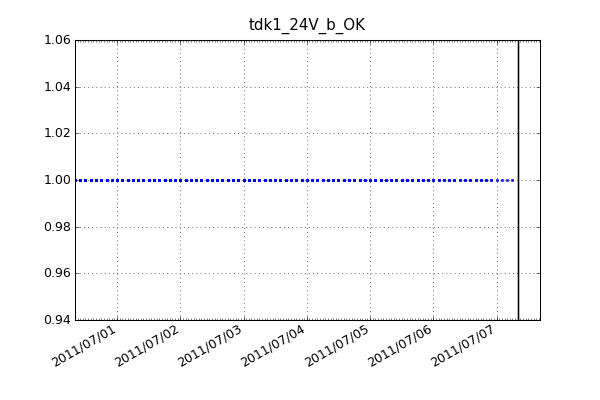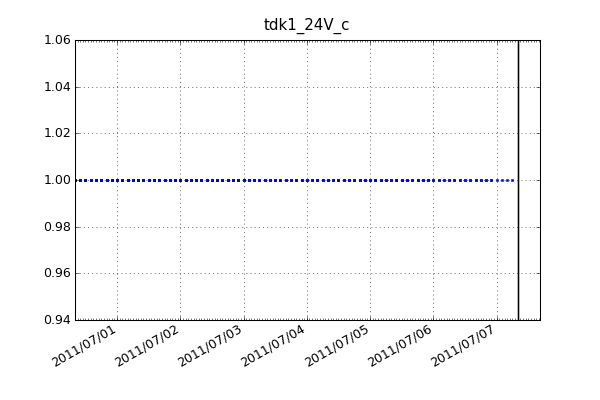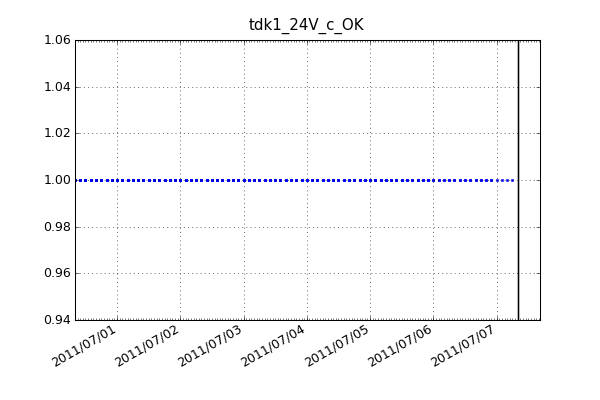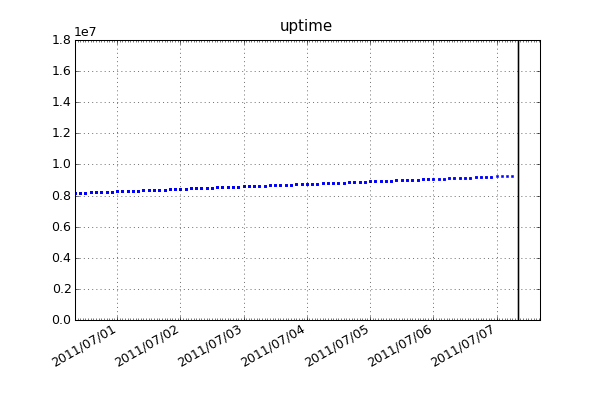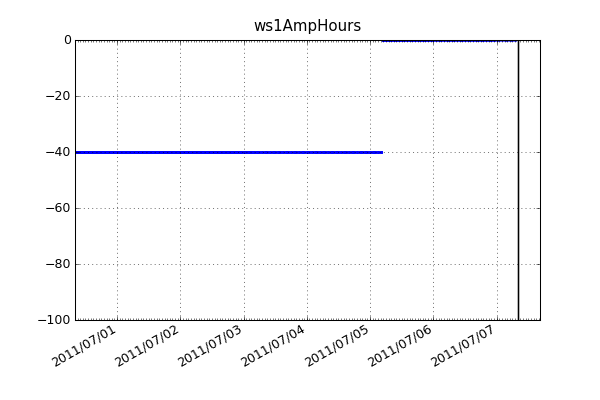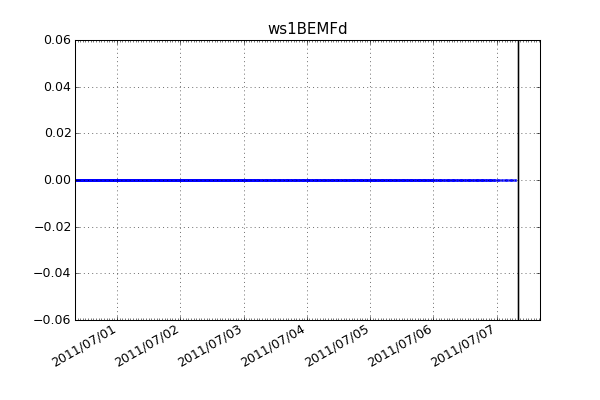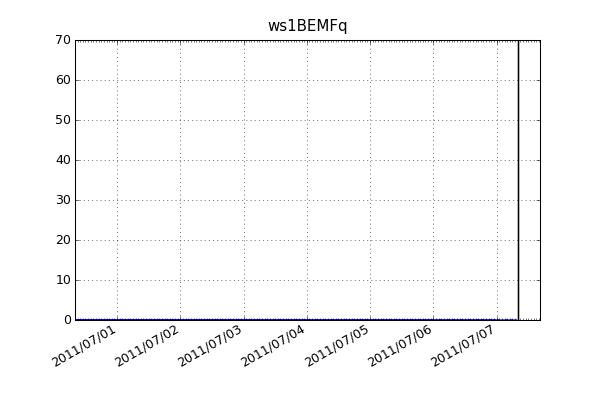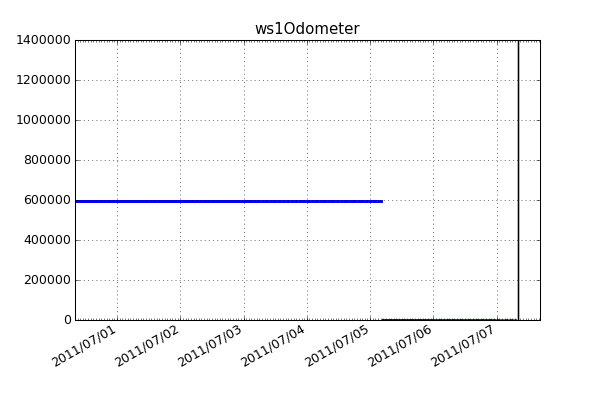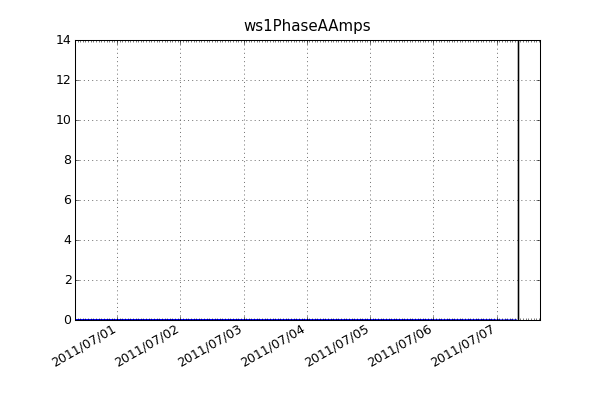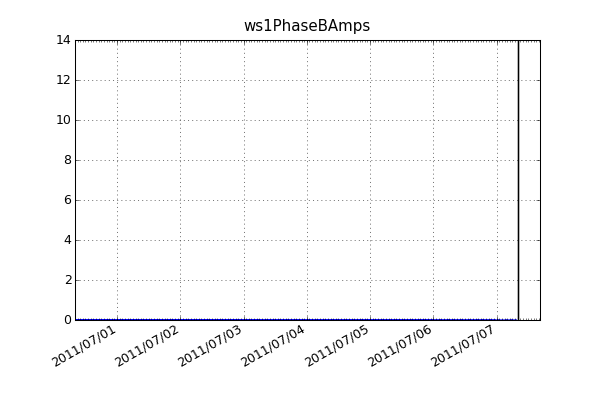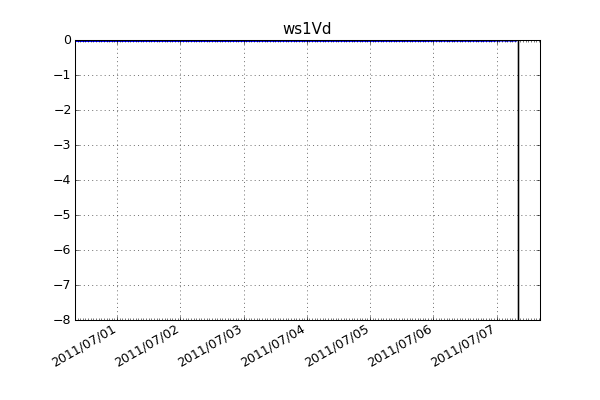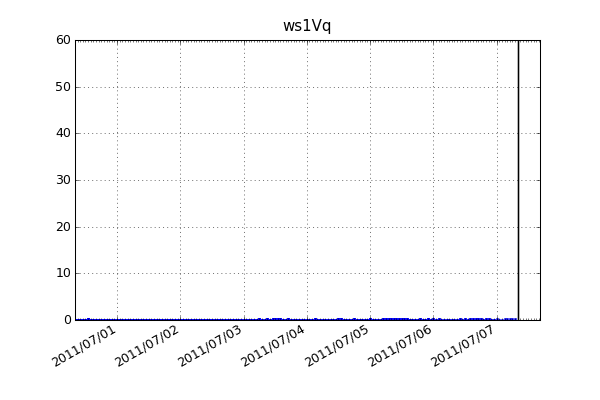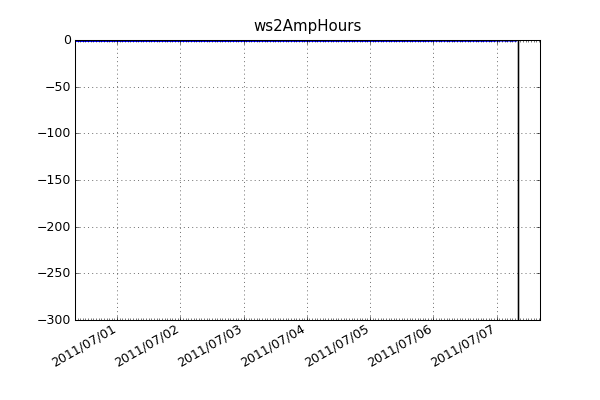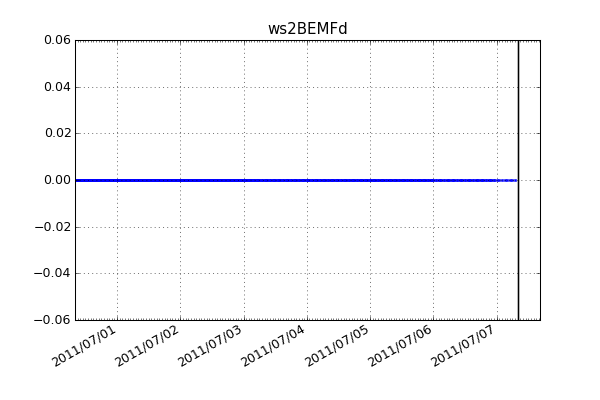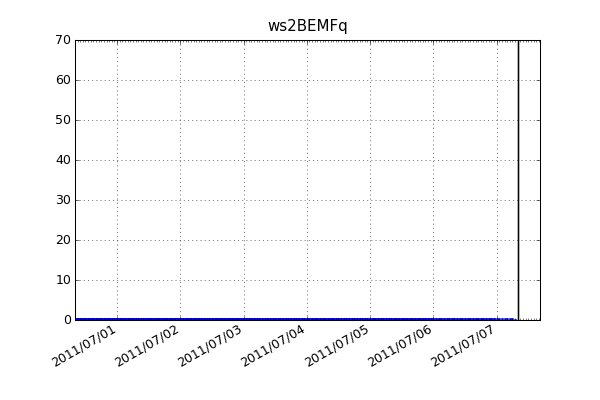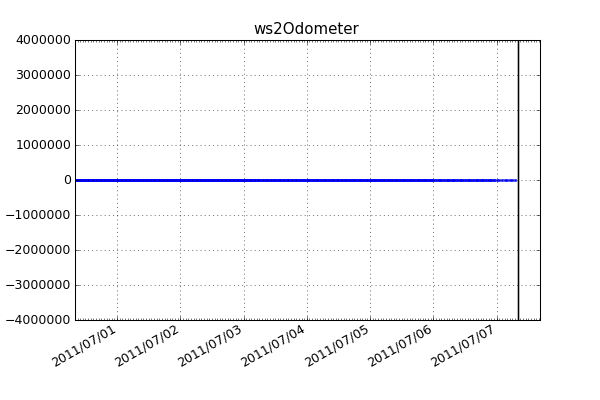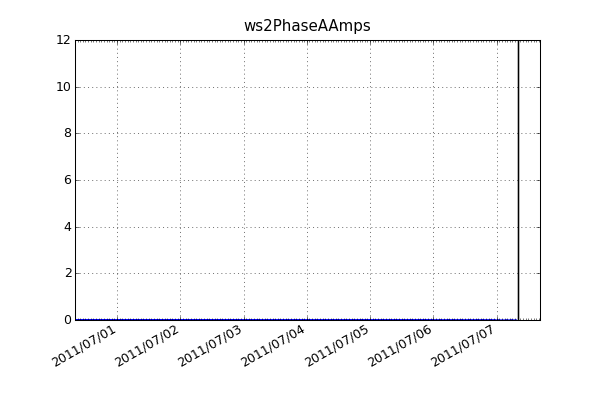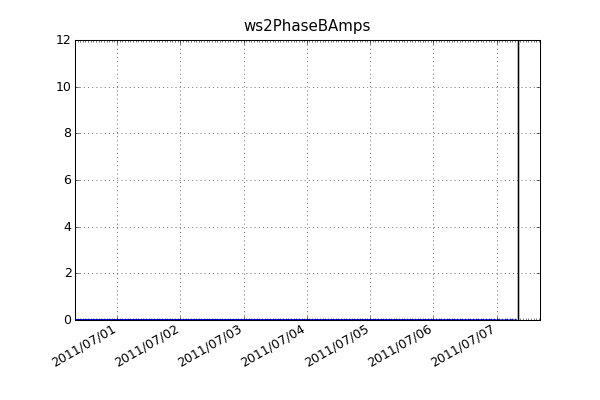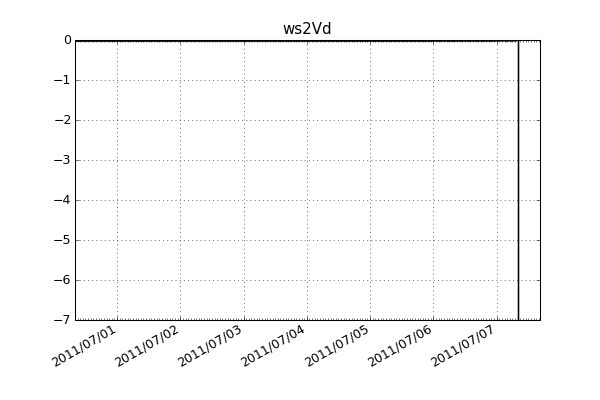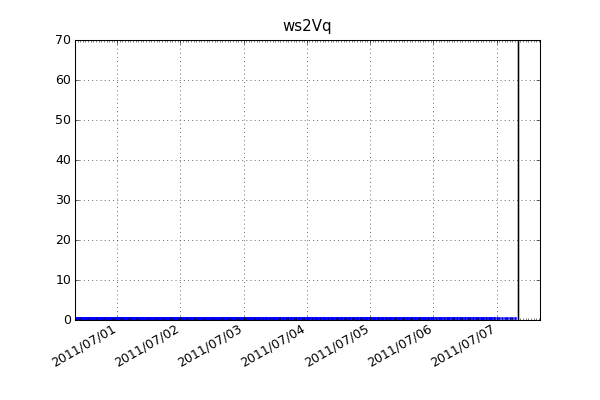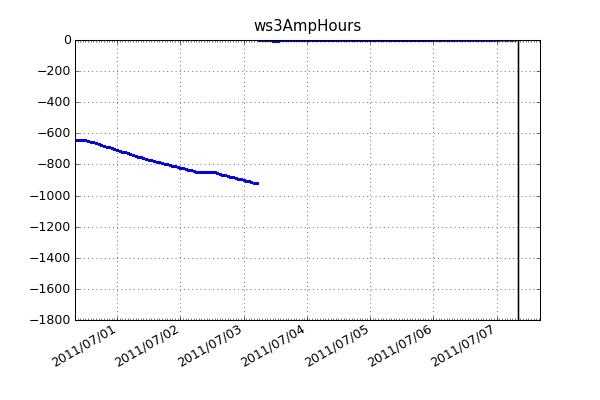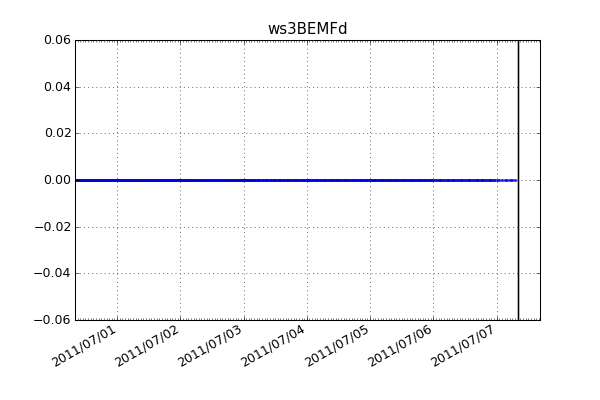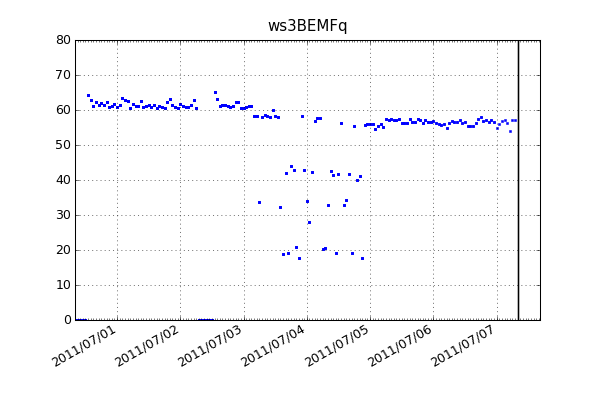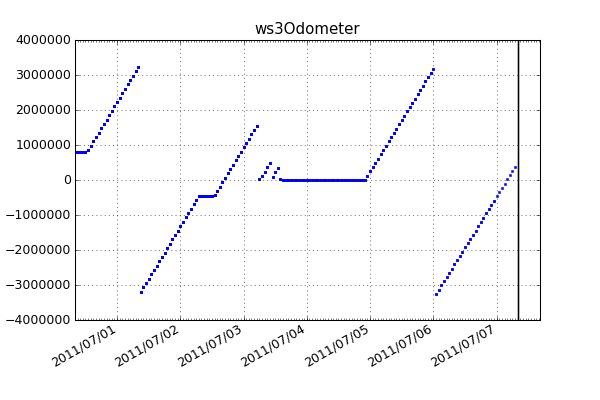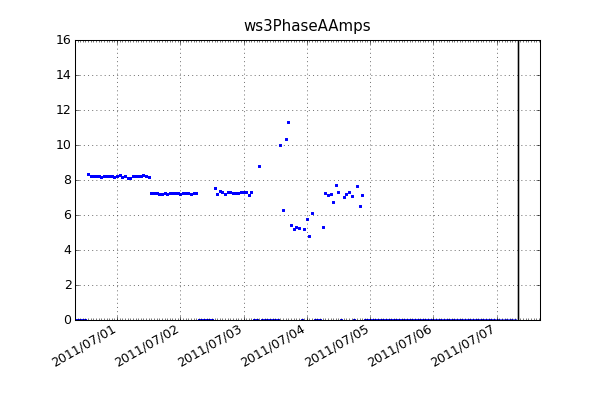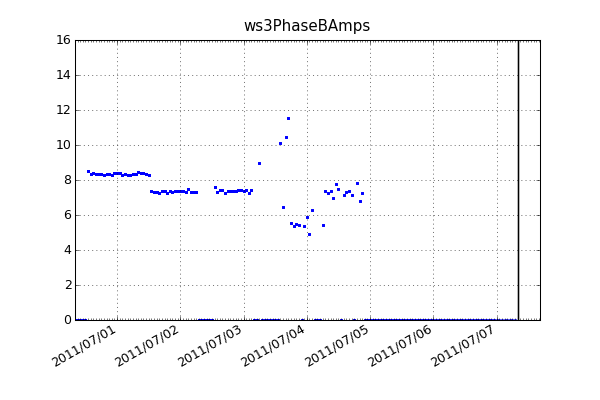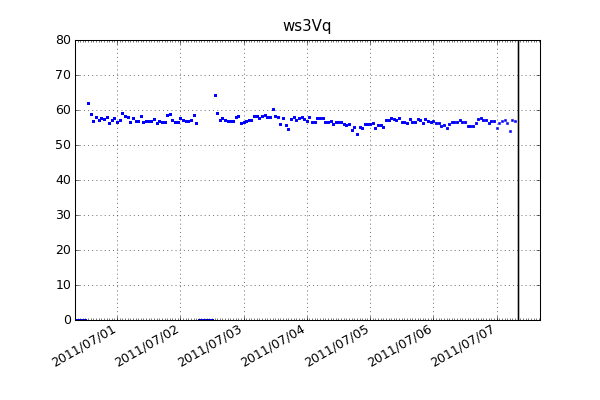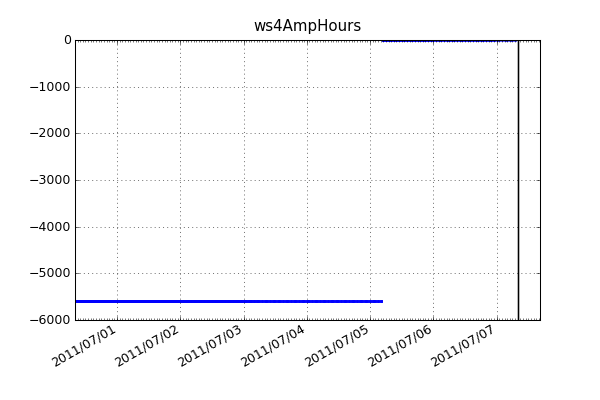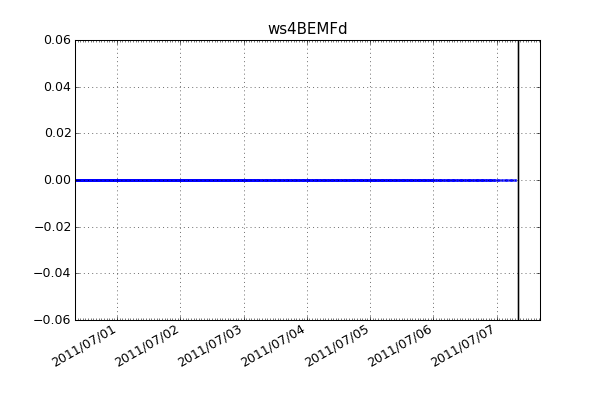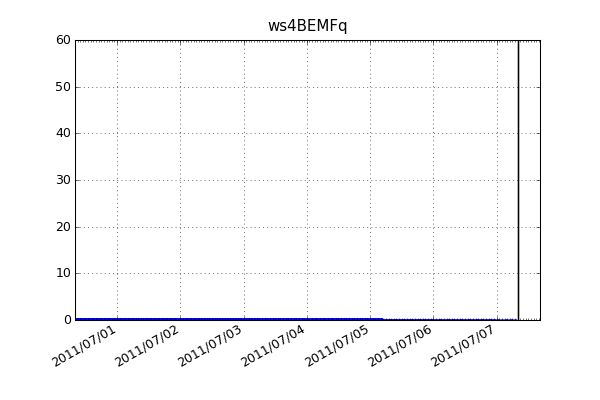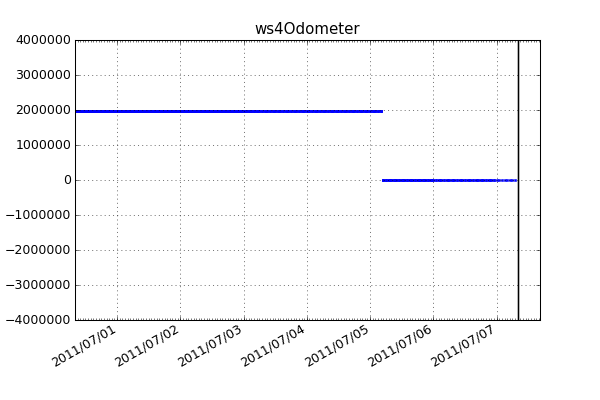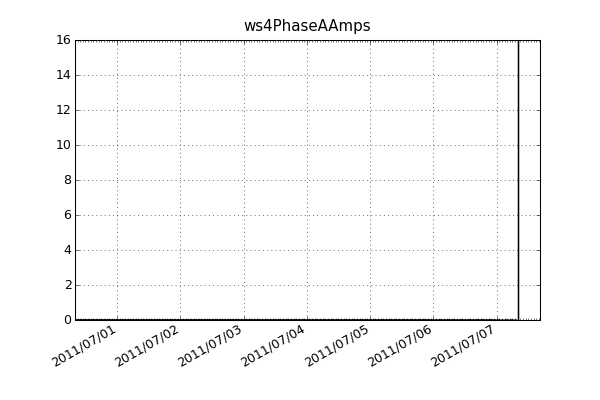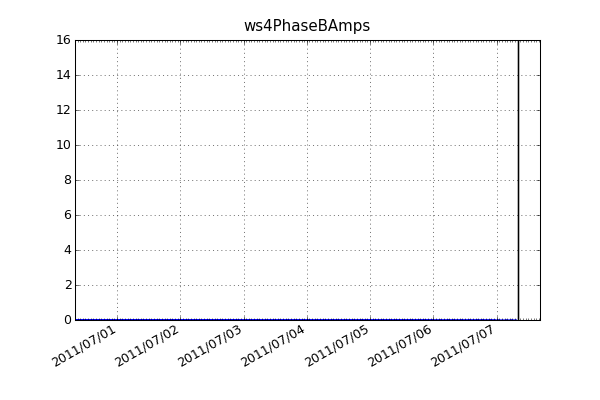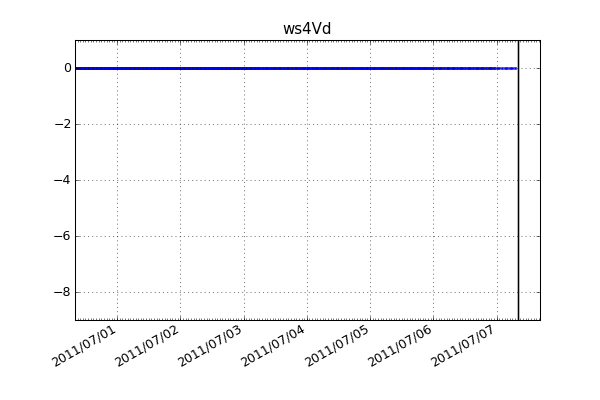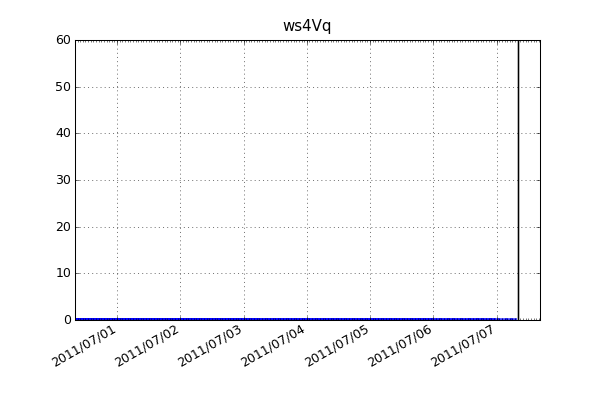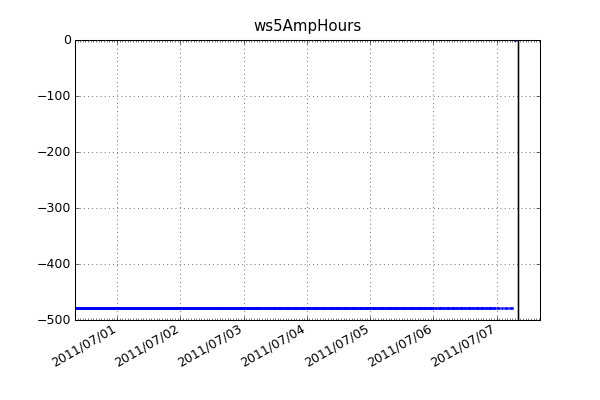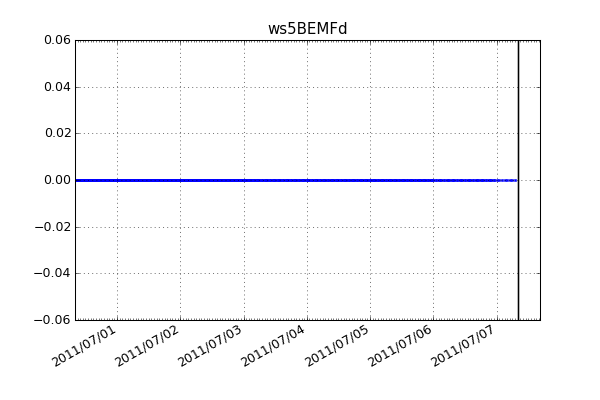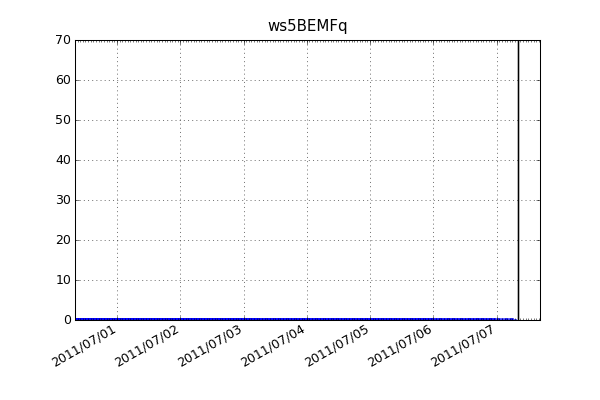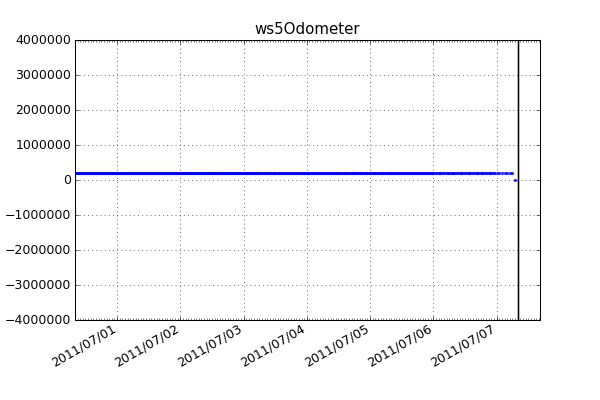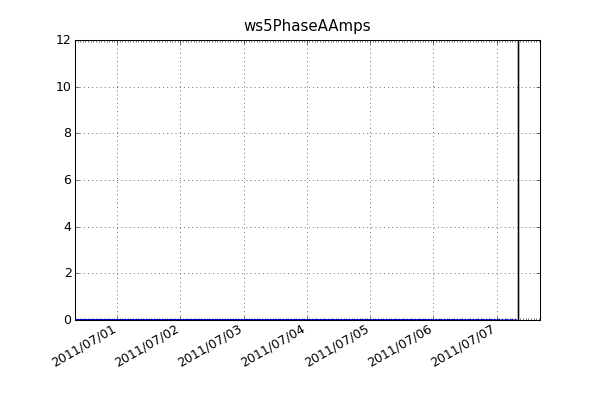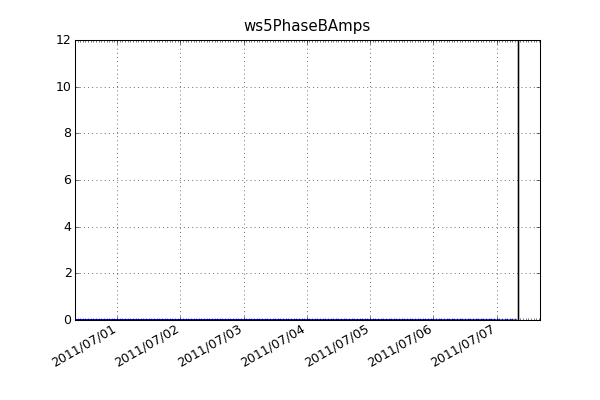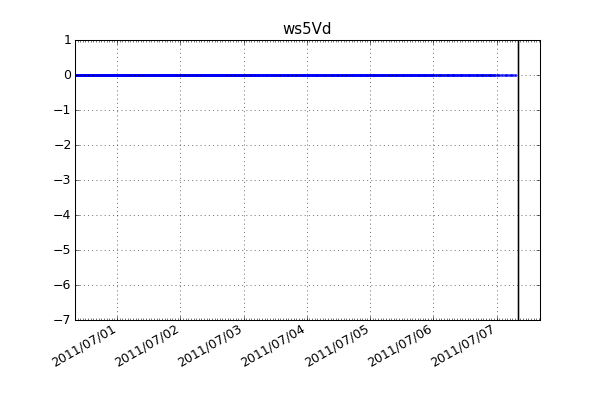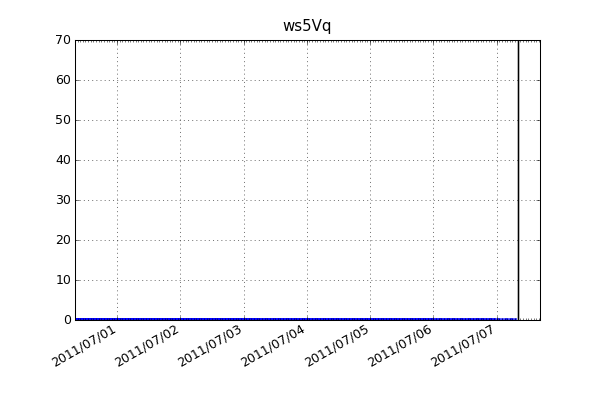PLATO-F plots for the last week
Welcome to the PLATO-F plots page. Here you can find many of the parameters that we monitor to make sure everything is running smoothly.
The page is divided into several categories: Instrument Module, Batteries, Solar power, Engine Module, Diesel engines, Current flow, Bus voltages, and Miscellaneous.
Click on any plot to enlarge it. In the image caption there are links to large versions of the plots in PNG format which are useful for sending in emails. Also in the caption you might notice the text (quick-link). If you bookmark or email this, it provides a direct jump to the graph of interest.
All times are in UTC and the plots have a vertical black bar that indicates the time when the plot was generated. This bar lets you know how old the data are and when the last update occurred. The plots are updated regularly. The side bar has links to plots of different time intervals if you need a closer look at what is happening now, or want to see what happened in the past.
Instrument Module
The Instrument Module contains most of the scientific experiments, the 20kWHr LiFePO4 battery pack, the Iridium communications equipment, the Linux supervisor computers, and the solar panel power supplies. The plots below show some parameters relevant to these systems.
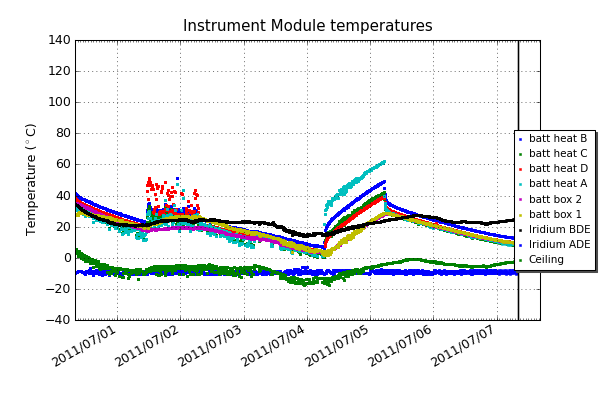 The black line is the temperature inside the Iridium OpenPort ADE (Above Deck Equipment, i.e., the antenna system). The battery heater temperature sensors are close to the heaters, so they will show a rapid response when the heaters are on. The "batt box 1" and "batt box 2" are more representative of the temperature near the batteries. See also the section on batteries, for more plots. (PNG, Quick-Link)
The black line is the temperature inside the Iridium OpenPort ADE (Above Deck Equipment, i.e., the antenna system). The battery heater temperature sensors are close to the heaters, so they will show a rapid response when the heaters are on. The "batt box 1" and "batt box 2" are more representative of the temperature near the batteries. See also the section on batteries, for more plots. (PNG, Quick-Link)
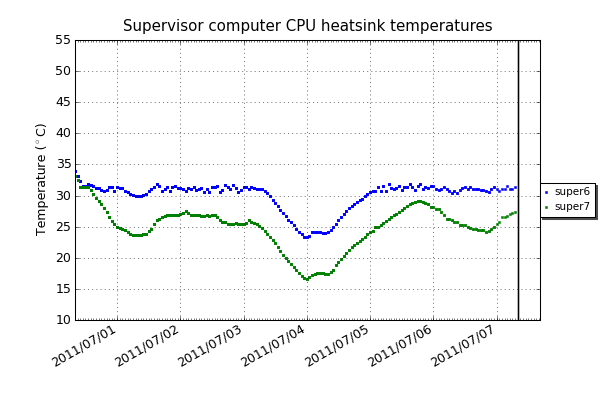 This plot shows the temperatures of the CPU heatsink in each of the two supervisor computers. The temperatures are regulated to some extent with a fan. (PNG, Quick-Link)
This plot shows the temperatures of the CPU heatsink in each of the two supervisor computers. The temperatures are regulated to some extent with a fan. (PNG, Quick-Link)
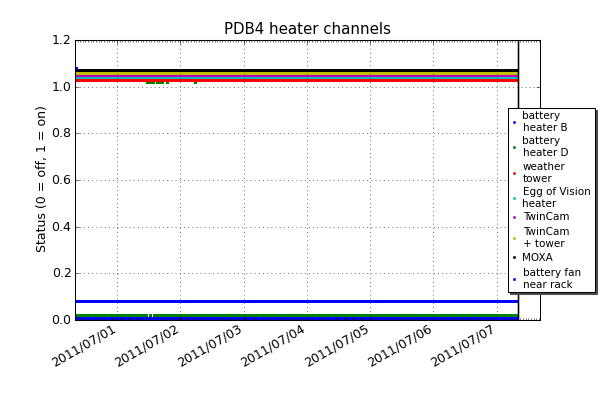 The on/off state of the "heater" channels in Power Distribution Board 4 (PDB4). The lines are offset slightly from each other so that you can distinguish between them. (PNG, Quick-Link)
The on/off state of the "heater" channels in Power Distribution Board 4 (PDB4). The lines are offset slightly from each other so that you can distinguish between them. (PNG, Quick-Link)
Batteries
The plots below show the voltages, currents, and temperatures of the 20kWHr LiFePO4 battery pack. The batteries consist of three parallel "strings" of thirty-six 60Ah LiFePO4 cells. Each string is nominally 120VDC. Each cell is typically about 3.3V, and varies from 2.8V when almost completely discharged up to an absolute maximum allowed voltage of 4.25V. Once a cell is charged to about 3.5 volts, it rapidly increases in voltage if charging continues.
String 1 is off-line, following an "event" on 15 February 2011 that we believe was due to the failure of a power-supply that in turn caused the Miniature Circuit Breaker in series with string 1 to trip.
In the first six plots below, each string is divided into two groups of 20 cells (4 of the cells aren't present, and read as zero).
The three strings are further divided into 4.5 packs of 8 cells, with each pack controlled by one "node".
The voltage readings for the first 4 cells of node 2 (labelled, e.g., "cell 1_2_0" through "cell 1_2_3") in each string tend to get "stuck" and don't change unless the node is power-cycled.
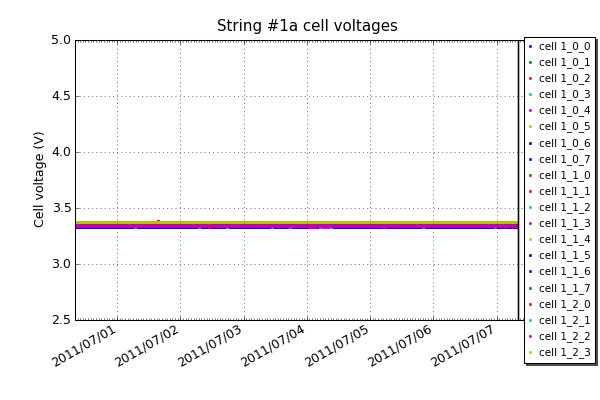 The voltages of the cells in the first half of string 1. This string went off-line on 15 February 2011. (PNG, Quick-Link)
The voltages of the cells in the first half of string 1. This string went off-line on 15 February 2011. (PNG, Quick-Link)
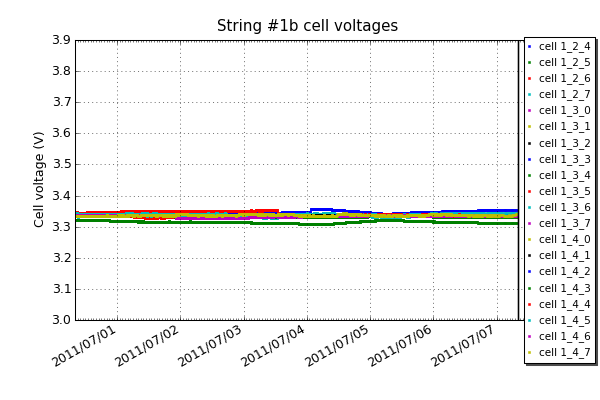 The voltages of the cells in the 2nd half of string 1. This string went off-line on 15 February 2011. (PNG, Quick-Link)
The voltages of the cells in the 2nd half of string 1. This string went off-line on 15 February 2011. (PNG, Quick-Link)
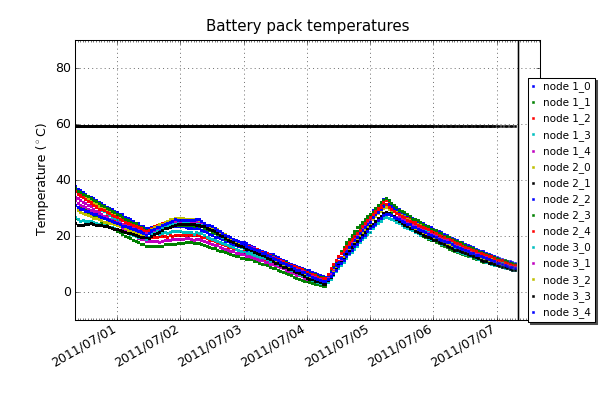 The temperatures of the packs of cells in our LiFePO4 batteries. Each group of eight cells has a thermistor near their centre to read their temperature. The cells can be heated by resistors that are at the base of the battery box. They can be cooled by blowing in air from the Instrument Module. They will also self-heat during charging/discharging. (PNG, Quick-Link)
The temperatures of the packs of cells in our LiFePO4 batteries. Each group of eight cells has a thermistor near their centre to read their temperature. The cells can be heated by resistors that are at the base of the battery box. They can be cooled by blowing in air from the Instrument Module. They will also self-heat during charging/discharging. (PNG, Quick-Link)
 The temperatures of the electronics boards (nodes) that monitor the individual groups of eight cells in the batteries. The node temperatures can rise if they are shunting cells during battery balancing. (PNG, Quick-Link)
The temperatures of the electronics boards (nodes) that monitor the individual groups of eight cells in the batteries. The node temperatures can rise if they are shunting cells during battery balancing. (PNG, Quick-Link)
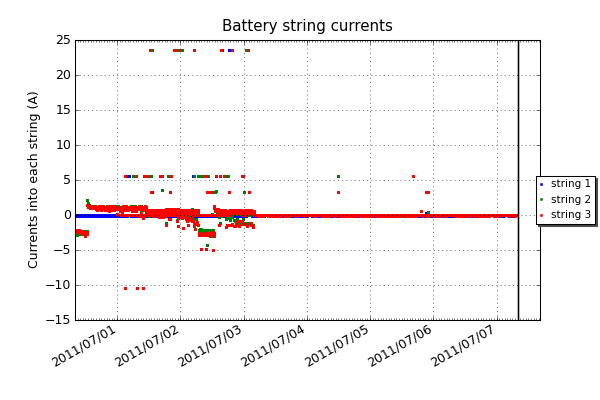 The currents into the three strings of LiFePO4 batteries. Positive currents indicate charging; negative discharging. String 1 reads zero following going off-line on 15 February 2011. The currents through strings 2 and 3 should be essentially identical. (PNG, Quick-Link)
The currents into the three strings of LiFePO4 batteries. Positive currents indicate charging; negative discharging. String 1 reads zero following going off-line on 15 February 2011. The currents through strings 2 and 3 should be essentially identical. (PNG, Quick-Link)
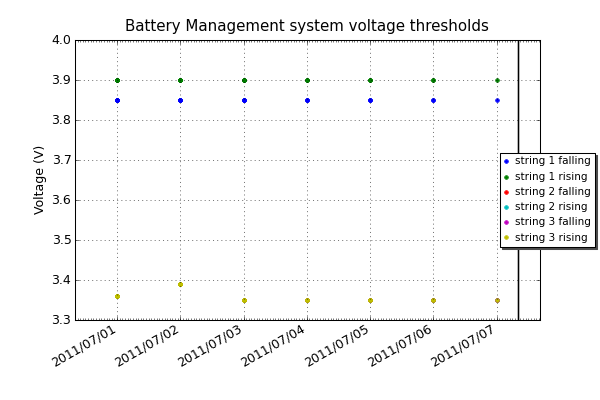 The setting of the Battery Management System voltage thresholds. These are the cell voltages at which a cell will be shunted with a 90mA current drain. The thresholds can be set on a per-string basis. Hysteresis is usually used. (PNG, Quick-Link)
The setting of the Battery Management System voltage thresholds. These are the cell voltages at which a cell will be shunted with a 90mA current drain. The thresholds can be set on a per-string basis. Hysteresis is usually used. (PNG, Quick-Link)
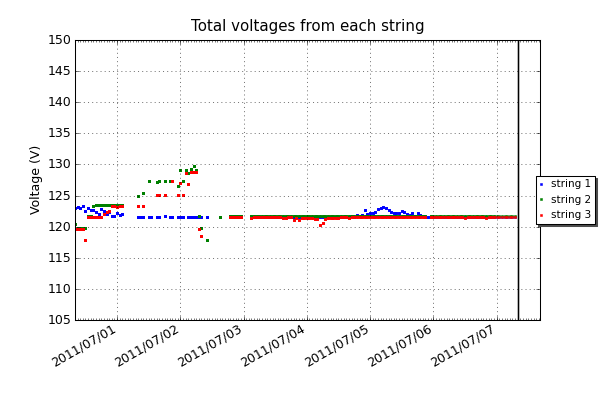 The total voltages from each of the three strings of LiFePO4 batteriesl. String 1 is slowly discharging, following the off-line event on 15 February 2011. (PNG, Quick-Link)
The total voltages from each of the three strings of LiFePO4 batteriesl. String 1 is slowly discharging, following the off-line event on 15 February 2011. (PNG, Quick-Link)
Solar power
PLATO-F has four pairs of 185W solar panels. Each pair faces a different direction, and feeds into an individual Maximum Power-Point Tracker (MPPT). The plots below show various parameters associated with the solar power.
When the sun is down, the plots don't show any data.
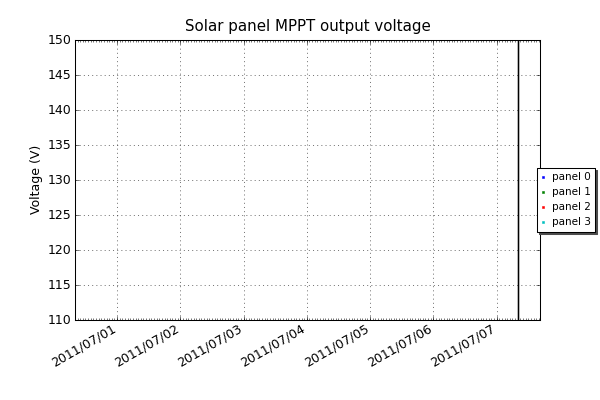 The voltages at the output of the solar panel Maximum Power Point Trackers. This voltage should be the same as our 120VDC nominal bus voltage, and should agree with the readings from the WaveSculptors and the battery management system. (PNG, Quick-Link)
The voltages at the output of the solar panel Maximum Power Point Trackers. This voltage should be the same as our 120VDC nominal bus voltage, and should agree with the readings from the WaveSculptors and the battery management system. (PNG, Quick-Link)
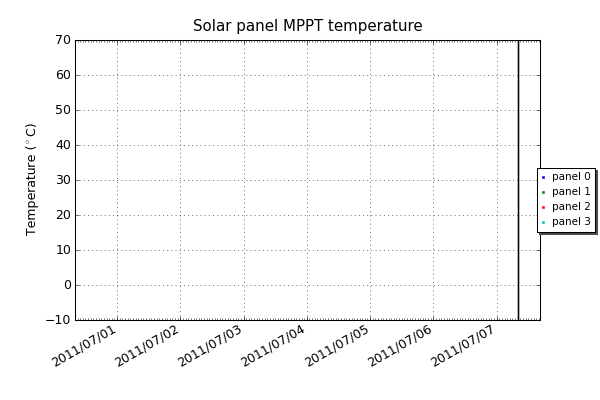 The temperatures of the Maximum Power Point Trackers that are used to generate power from our four pairs of 185W solar panels. The trackers warm up when generating power. When the sun is down, the trackers turn off, and we don't receive any data from them. (PNG, Quick-Link)
The temperatures of the Maximum Power Point Trackers that are used to generate power from our four pairs of 185W solar panels. The trackers warm up when generating power. When the sun is down, the trackers turn off, and we don't receive any data from them. (PNG, Quick-Link)
Engine Module
The PLATO-F Engine Module contains five Hatz 1B-30 diesel engines, 6000 litres of kerosene, and various electronic control systems.
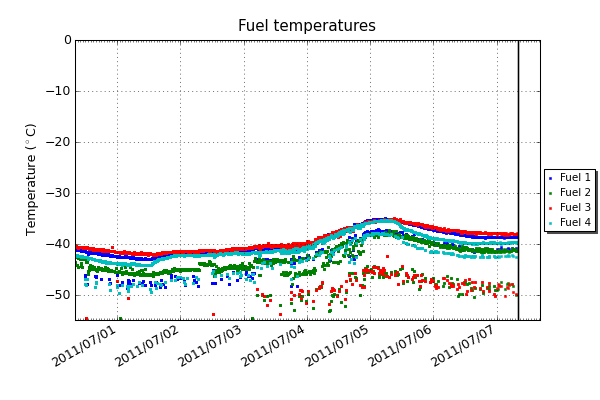 The temperature read by four sensors at the bottom of the fuel bladder in the Engine Module. The sensor data are noisy when the ventilation fan is on. (PNG, Quick-Link)
The temperature read by four sensors at the bottom of the fuel bladder in the Engine Module. The sensor data are noisy when the ventilation fan is on. (PNG, Quick-Link)
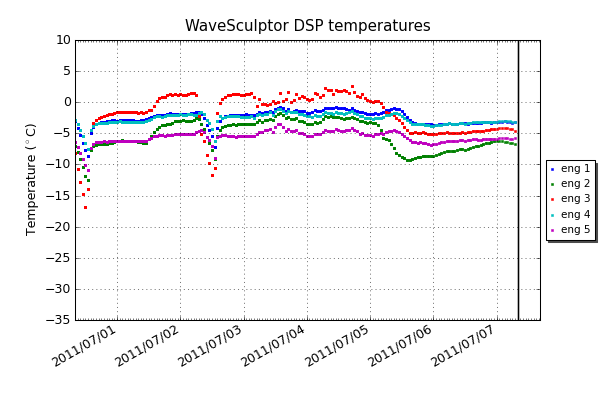 The temperatures of the WaveSculptor digital signal processors. These temperatures should be close to the temperature of the metal plates that form the base of the engine modules. (PNG, Quick-Link)
The temperatures of the WaveSculptor digital signal processors. These temperatures should be close to the temperature of the metal plates that form the base of the engine modules. (PNG, Quick-Link)
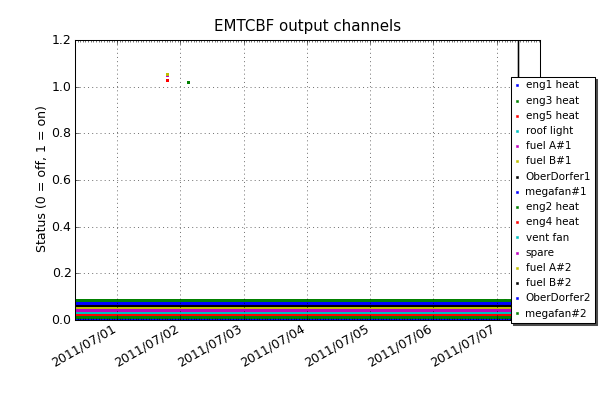 The on/off state of the "heater" and "power" channels in the Engine Module Thermal Control Box, Dome-F (EMTCBF). The lines are offset slightly so that the individual channels can be distingished. (PNG, Quick-Link)
The on/off state of the "heater" and "power" channels in the Engine Module Thermal Control Box, Dome-F (EMTCBF). The lines are offset slightly so that the individual channels can be distingished. (PNG, Quick-Link)
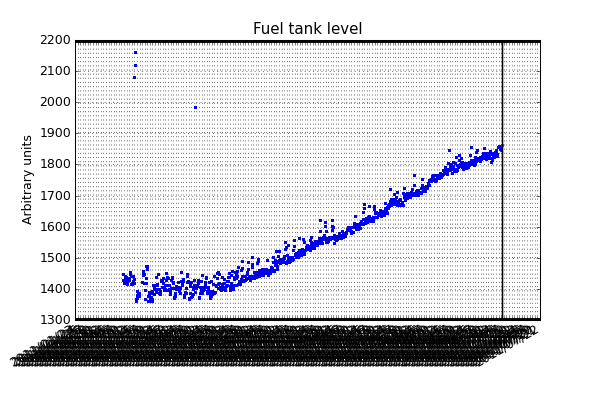 The amount of fuel remaining in the 6000 litre fuel tank. This number is uncalibrated at the moment. (PNG, Quick-Link)
The amount of fuel remaining in the 6000 litre fuel tank. This number is uncalibrated at the moment. (PNG, Quick-Link)
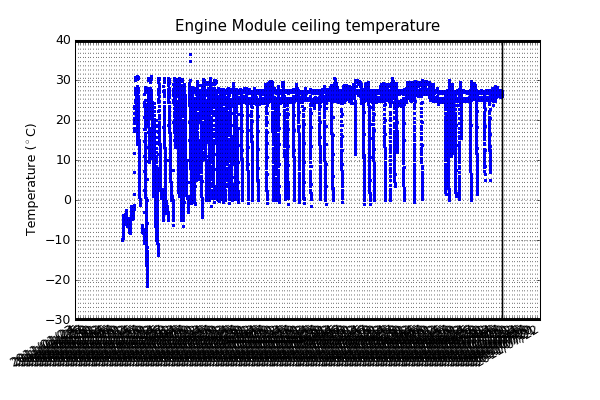 The temperature read by an AD590 sensor at the centre of the ceiling in the Engine Module. This temperature should be above -13C to allow the engines to start. (PNG, Quick-Link)
The temperature read by an AD590 sensor at the centre of the ceiling in the Engine Module. This temperature should be above -13C to allow the engines to start. (PNG, Quick-Link)
Diesel engines
The five Hatz 1B-30 diesel engines in PLATO-F are connected to three-phase alternators with a capacity of about 1.5kW. The engines are controlled by Tritium WaveSculptors, which not only allow us to start the engines (by driving current into the alternators), but give us precise load control.
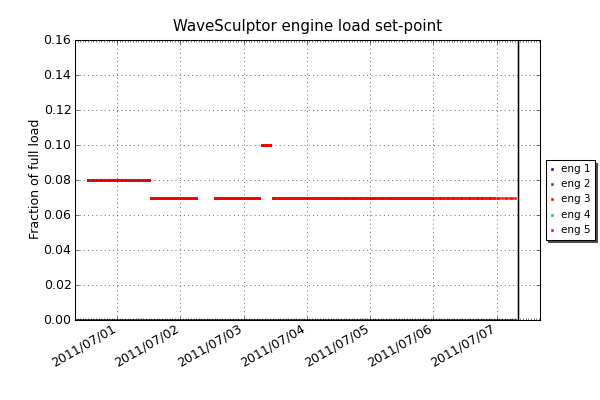 The fraction of the maximum possible load that the engines are being asked to deliver. In practice 0.1 corresponds to about 1kW. The maximum practical continuous load is around 0.12, limited by the temperature of the alternators. (PNG, Quick-Link)
The fraction of the maximum possible load that the engines are being asked to deliver. In practice 0.1 corresponds to about 1kW. The maximum practical continuous load is around 0.12, limited by the temperature of the alternators. (PNG, Quick-Link)
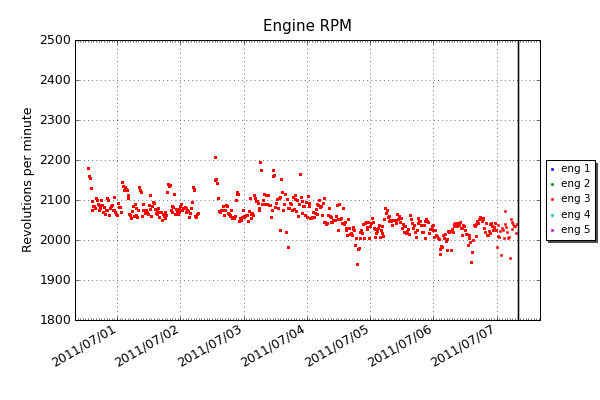 The engine revolutions per minute (RPM). The nominal no-load set-point is 2000 RPM. (PNG, Quick-Link)
The engine revolutions per minute (RPM). The nominal no-load set-point is 2000 RPM. (PNG, Quick-Link)
 The temperatures of the engine cylinder heads. The thermocouples do not read below about 5C. The engines are warmed either by being on, from heat from a neighbouring engine, or from 150W of electrical heaters on an aluminium plate to which each engine is bolted. (PNG, Quick-Link)
The temperatures of the engine cylinder heads. The thermocouples do not read below about 5C. The engines are warmed either by being on, from heat from a neighbouring engine, or from 150W of electrical heaters on an aluminium plate to which each engine is bolted. (PNG, Quick-Link)
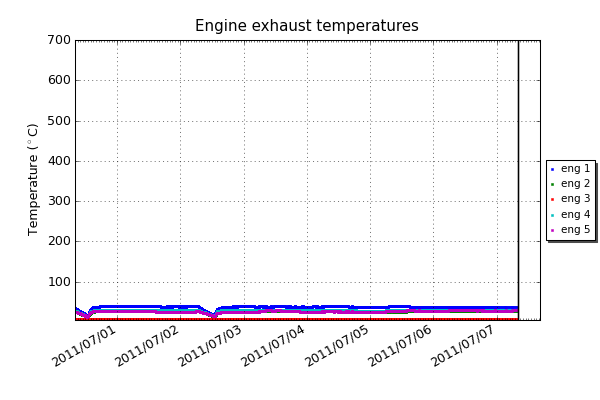 The temperatures of the engine exhausts. The thermocouples do not read below about 5C. The exhaust temperature is measured in the centre of the output port, between the cylinder head and the muffler. (PNG, Quick-Link)
The temperatures of the engine exhausts. The thermocouples do not read below about 5C. The exhaust temperature is measured in the centre of the output port, between the cylinder head and the muffler. (PNG, Quick-Link)
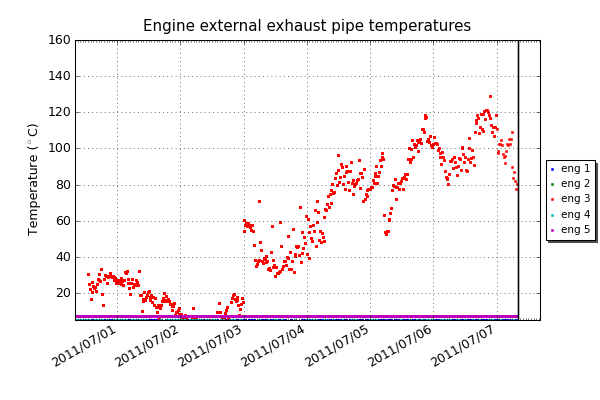 The temperatures of the external exhaust pipe, as measured about 5mm radially in from the edge of the exhaust pipe, in the ambient Antarctic air. The thermocouples do not read below about 5C. Only three of the engines are instrumented with external exhaust pipe thermocouples. (PNG, Quick-Link)
The temperatures of the external exhaust pipe, as measured about 5mm radially in from the edge of the exhaust pipe, in the ambient Antarctic air. The thermocouples do not read below about 5C. Only three of the engines are instrumented with external exhaust pipe thermocouples. (PNG, Quick-Link)
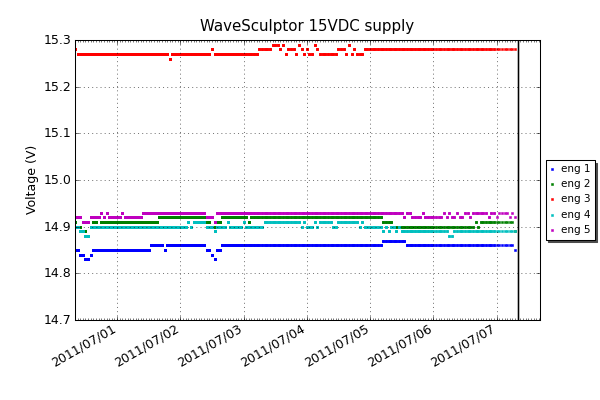 The WaveSculptor 15VDC supply. This supply is generated internally within the WaveSculptor. (PNG, Quick-Link)
The WaveSculptor 15VDC supply. This supply is generated internally within the WaveSculptor. (PNG, Quick-Link)
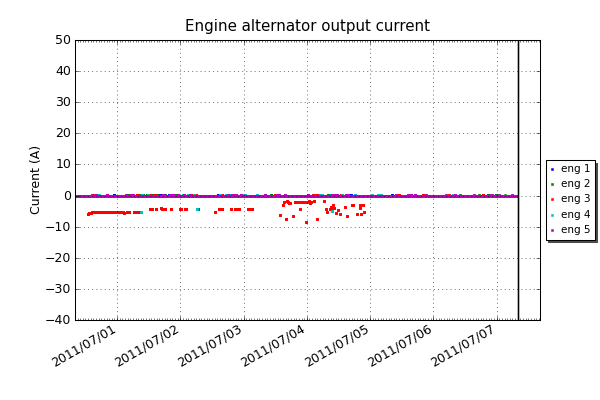 The current provided to the alternators on the engines by the PLATO-F 120VDC bus. The current is negative when the engines are supplying power. (PNG, Quick-Link)
The current provided to the alternators on the engines by the PLATO-F 120VDC bus. The current is negative when the engines are supplying power. (PNG, Quick-Link)
Current flow
The plots below show ...
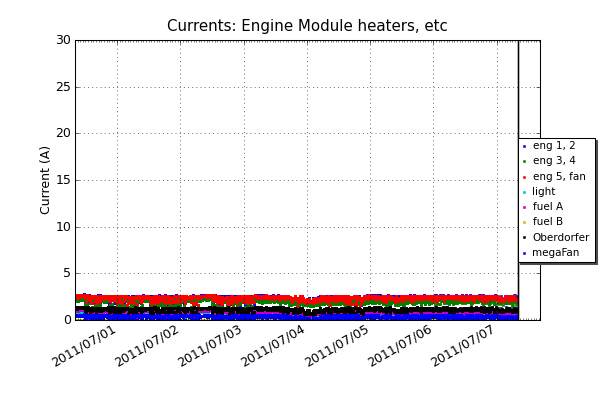 The current drawn by the heaters, and other miscellaneous items, in the Engine Module. (PNG, Quick-Link)
The current drawn by the heaters, and other miscellaneous items, in the Engine Module. (PNG, Quick-Link)
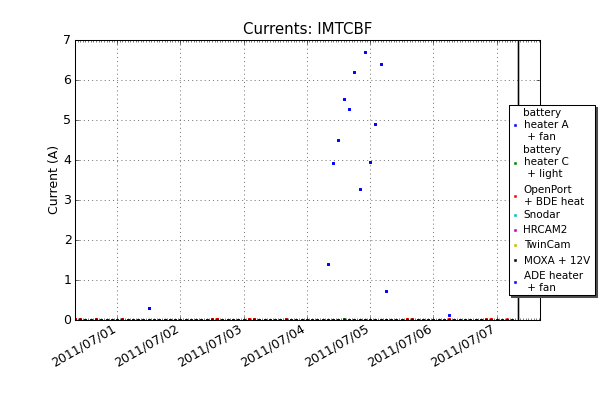 The current drawn by devices connected to the EMTCBF. A hardware fault has resulted in these currents being zero. We plot them here in case they become non-zero in the future. (PNG, Quick-Link)
The current drawn by devices connected to the EMTCBF. A hardware fault has resulted in these currents being zero. We plot them here in case they become non-zero in the future. (PNG, Quick-Link)
Bus voltages
The plots below show...
Miscellaneous
The plots below show...

